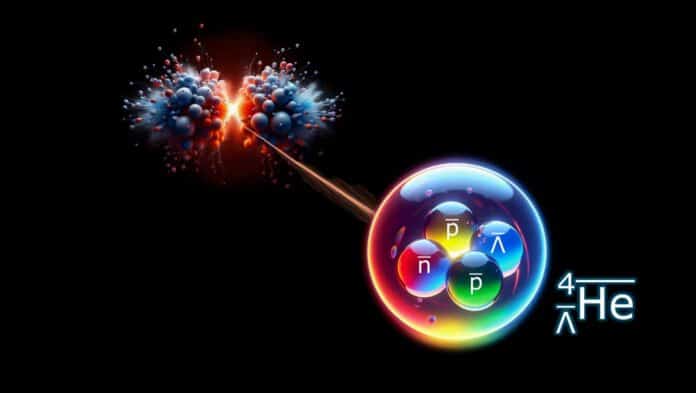
By Amit Malewar 10 Dec, 2024
Collected at: https://www.techexplorist.com/first-ever-evidence-antimatter-partner-hyperhelium-4/94338/
Collisions between heavy ions at the Large Hadron Collider (LHC) create quark-gluon plasma, a state of matter thought to have existed shortly after the Big Bang. These collisions also produce atomic nuclei, exotic hypernuclei, and antimatter counterparts. Studying these forms of matter helps scientists understand hadron formation and the matter-antimatter imbalance in the Universe.
Hypernuclei are rare, exotic nuclei of protons, neutrons, and hyperons (particles with strange quarks). Despite being discovered over 70 years ago in cosmic rays, hypernuclei remain challenging to study in the lab, making them an ongoing focus of interest for physicists.
In heavy-ion collisions, hypernuclei are produced in significant amounts, with the hypertriton (composed of a proton, neutron, and lambda hyperon) and its antimatter counterpart, antihypertriton, being the only ones observed until recently. Hypertriton contains a lambda hyperon, which holds a strange quark, while antihypertriton consists of an antiproton, an antineutron, and an antilambda.
Following the discovery of antihyperhydrogen-4 (a bound state of an antiproton, two antineutrons, and an antilambda) by the STAR collaboration, the ALICE collaboration at the LHC has now observed the first evidence of antihyperhelium-4, the heaviest antimatter hypernucleus detected so far.
Antihyperhelium-4 consists of two antiprotons, an antineutron and an antilambda. With a significance of 3.5 standard deviations, this discovery marks the first detection of such a heavy antimatter hypernucleus at the LHC.
The ALICE collaboration used lead-lead collision data from 2018 at the LHC (5.02 TeV per colliding nucleon) to observe rare antimatter hypernuclei. They employed a machine-learning technique that outperformed traditional search methods. They searched for signals of hyperhydrogen-4, hyperhelium, and their antimatter counterparts.
Candidates for (anti)hyperhydrogen-4 were identified through the decay of (anti)helium-4 and a charged pion. In contrast (anti)hyperhelium-4 candidates were found via its decay into an (anti)helium-3 nucleus, an (anti)proton, and a charged pion.
The ALICE team provided evidence for antihyperhelium-4 with 3.5 standard deviations and antihyperhydrogen-4 with 4.5 standard deviations. They also measured both hypernuclei’s production yields and masses, marking significant advancements in studying exotic antimatter.
The ALICE collaboration’s measurements of hypernuclei masses are consistent with current world-average values. Their production yields were compared to predictions from the statistical hadronization model, which describes hadron and nucleus formation in heavy-ion collisions.
The model closely matched the data when both excited and ground states of hypernuclei were included, confirming that it accurately describes the production of hypernuclei, which are compact objects around 2 femtometers in size.
When calculating the antiparticle-to-particle yield ratios for both hypernuclei, they were consistent with unity within experimental uncertainties. This result aligns with previous ALICE findings showing equal production of matter and antimatter at LHC energies. According to the authors, it contributes to the ongoing study of the matter-antimatter imbalance in the Universe.
Journal Reference:
- ALICE Collaboration. First measurement of A = 4 (anti)hypernuclei at the LHC. arXiv:2410.17769

Leave a Reply